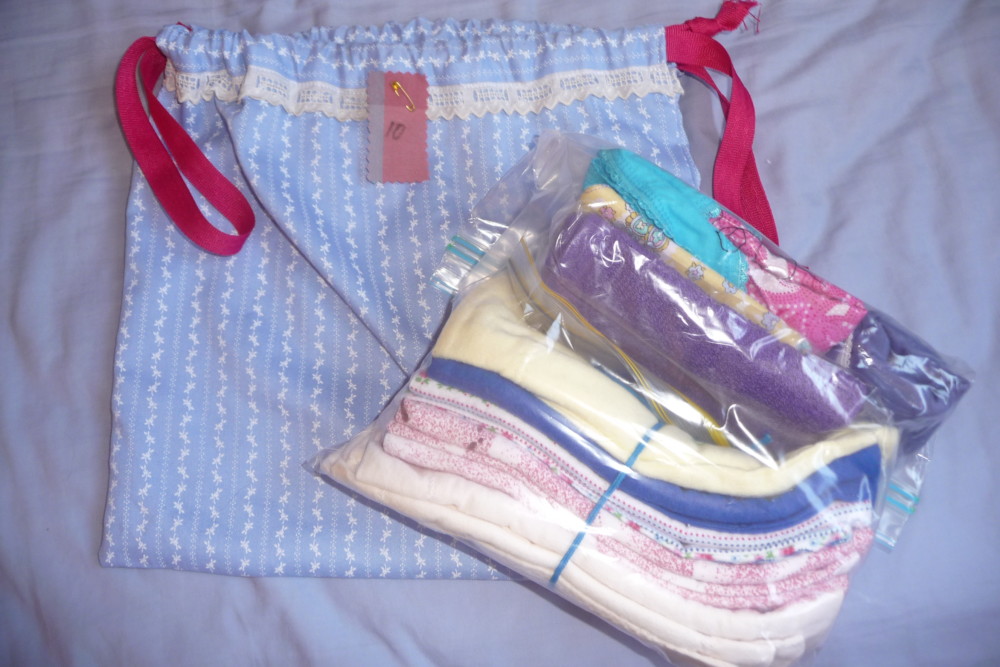By Tammy Ayer
Yakima Herald-Republic, Wash.
WWR Article Summary (tl;dr) In many parts of the developing world, where access to tampons and pads is limited or nonexistent, girls are often forced to stay home when they get their period, losing a week of school each month. The non-profit “Days for Girls International” is doing everything it can to change that.
YAKIMA, Wash.
Dan Corbett held up piece of tie-dyed cotton rich with deep hues of purple, blue, green and gold.
“This is a beautiful fabric,” he said as he sat at a sewing machine surrounded by more swatches and others busy at their sewing machines in the pastoral center near Holy Family Catholic Church.
Corbett and wife Benita were among about a dozen people who gathered Wednesday to create drawstring bags that would hold hygiene kits sent to girls in countries around the world.
The washable feminine hygiene kits they help make for Days for Girls ensures that young women can stay in school during their period — an opportunity that can change their lives.
Celeste Mergens founded Days for Girls International in 2008 after her work in Kenya led her to wonder what girls were doing for feminine hygiene. The nonprofit has reached more than 1 million women and girls in more than 116 countries with hygiene kits and menstrual health education, according to its website, www.daysforgirls.org.
Those kits include more than 5,000 that volunteers with the Days for Girls Yakima Team have created and assembled since organizer Toni McBean founded the local group three years ago this month. The team will celebrate its third anniversary and make more kits during a special event Saturday at the Harman Center in Yakima.
“It’s a great humanitarian project … with most of the work being done at home by ladies of all ages,” McBean said. “It has just grown tremendously in the Yakima Valley.”
In many parts of the developing world, where access to tampons and pads is limited or nonexistent, girls are often forced to stay home when they get their period, losing a week of school each month.
“After months of missing a week of school, they have to drop out,” McBean said. “If they can stay in school, then they have a chance at a normal life.
“What we make will last a girl three to four years,” added McBean, who knows of one girl who made her kit last five years so she could graduate.
“It’s totally volunteer … and everything is donated, mainly the time.”
The Corbetts join members of Catholic Daughters who meet every Wednesday of every month but December. You don’t have to belong to help, though, member Marilyn Blanchard said of the group, which enjoys fellowship as part of their work.
Ann Lewis, a member of the Church of Jesus Christ of Latter-Day Saints, trained McBean. She recently returned home to Orem after a three-year mission in Yakima with husband John.
Lewis lived in Africa for several years and saw what girls faced. After coming back to the U.S., she started Days for Girls efforts in Utah.
“I pretty much did this full-time. My car was like a moving van,” Lewis said last week. “We involved hundreds and hundreds of women in a very short amount of time.”
One of the project’s major appeals is that it involves a variety of tasks of different skill levels. While some are experienced sewers like the Corbetts and their friend Terry Krebs, others can tackle less challenging jobs.
Some iron; some mark straight lines on fabric or pin or sew on small square orange Days for Girls tags. Donated mattress binding tape becomes drawstrings; volunteers singe the edges to ensure they don’t fray.
“There are dozens of home sewers who come and take supplies home,” Lewis said. “There’s work that can be done on your own time.”
“There’s something for every skill level,” she added.
The homemade kits have multiple components. They include eight pads made of colorful flannel (no whites or pastels, to avoid the stigma that comes with bloodstains); two “moisture-barrier” shields made with polyurethane leak-proof fabric, in which the pads are inserted; two gallon-size Ziploc freezer bags, in which girls can wash the pads using minimal water; and a colorful drawstring bag to hold all the materials.
They also include a washcloth, a travel-sized bar of soap, two pairs of regular underwear and a visual instruction sheet explaining the kits.
The kits that Valley volunteers have made have gone around the world — to Zimbabwe and other African counties; to Haiti; to Guatemala and Nicaragua, Lewis said.
“We’ve sent kits with the medical students that do their internships out in the world,” she said. “Last summer they took several hundred.”
The Days for Girls bags last long enough for the girls who carry them to get a high school education. And the impact doesn’t stop there.
“A mother that’s educated will make sure her kids are educated,” she said.














































































































































































































































































































































































